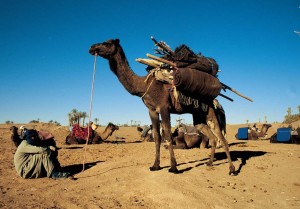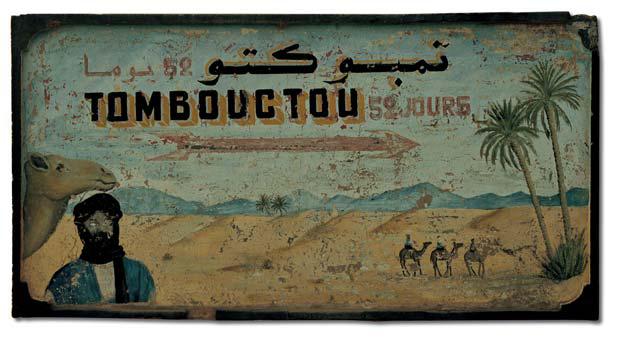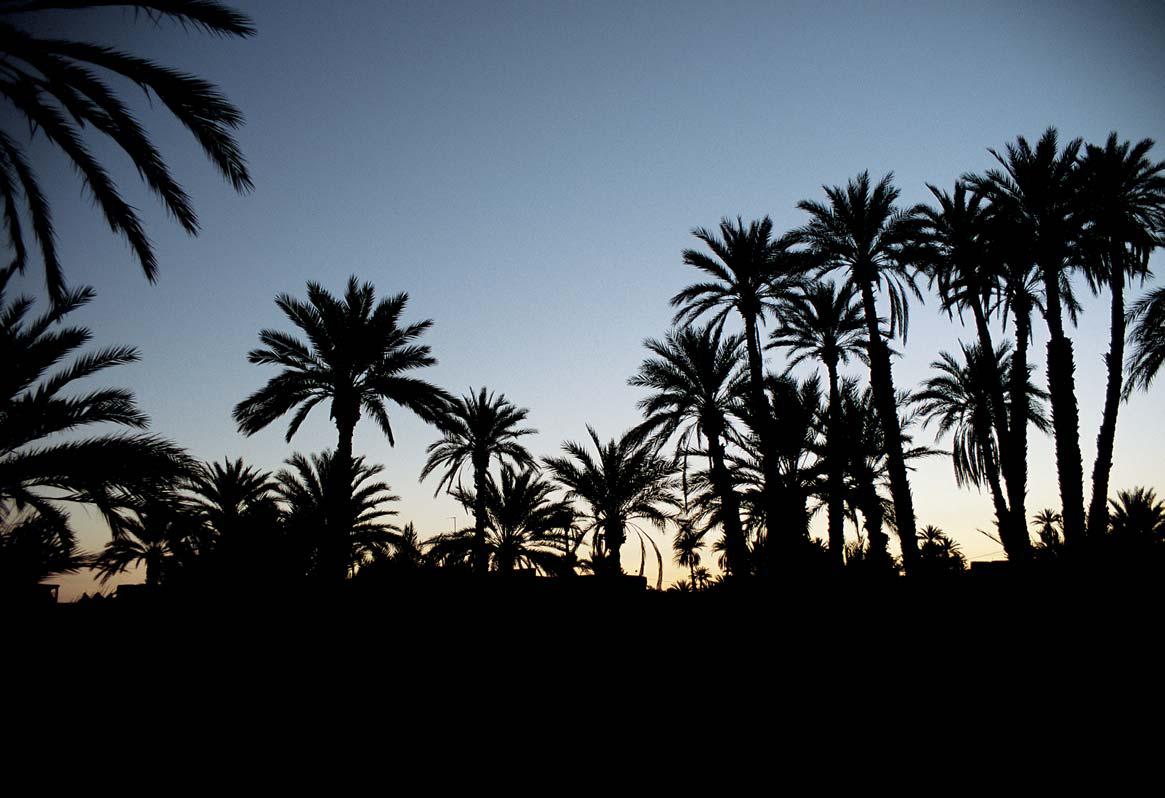 Sahara: With typical moroccan business acumen, the little town of Zagora trades on its location as ‘La Porte au Sahara’, aiming to cash in on the romance-of-the-desert dreamers who wash up here from time to time. At the end of the main street, a flaking sign depicts stiff-legged camels ferrying blue-robed riders through a child’s-eye landscape of dunes and date-palms. The legend reads ‘Timbuktu 52 days’. I had come to Zagora with a handful of kindred souls. We might not get as far as Timbuktu, but we did want to sample at least a taste of the old life of the desert. The hoteliers of Zagora weren’t deterred by the fact that only the outermost fringes of Morocco are brushed by the Sahara. True, a few stray dunes curled across the plain at nearby Tinfou; but only south of Jebel Bani, the last major massif, did I feel unambiguously in the desert. Vegetation grew sparse where we veered off the tar near Beni Ali, bumping along unmade tracks towards our rendezvous with desert men whose forebears had routinely crossed the entire Sahara to bring back gold and slaves.
Sahara: With typical moroccan business acumen, the little town of Zagora trades on its location as ‘La Porte au Sahara’, aiming to cash in on the romance-of-the-desert dreamers who wash up here from time to time. At the end of the main street, a flaking sign depicts stiff-legged camels ferrying blue-robed riders through a child’s-eye landscape of dunes and date-palms. The legend reads ‘Timbuktu 52 days’. I had come to Zagora with a handful of kindred souls. We might not get as far as Timbuktu, but we did want to sample at least a taste of the old life of the desert. The hoteliers of Zagora weren’t deterred by the fact that only the outermost fringes of Morocco are brushed by the Sahara. True, a few stray dunes curled across the plain at nearby Tinfou; but only south of Jebel Bani, the last major massif, did I feel unambiguously in the desert. Vegetation grew sparse where we veered off the tar near Beni Ali, bumping along unmade tracks towards our rendezvous with desert men whose forebears had routinely crossed the entire Sahara to bring back gold and slaves.
Late in the afternoon, the camel men drifted in with strings of camels in tow: lean men, dark-eyed, and muffled against the sun in black and sky-blue head cloths. They spoke their names quietly, as though at ease with the silence of empty places: “Abdulrahim,” “Omar,” “Mehmet,” “Ibrahim.” In fading daylight, we set out along the Draa’s dry riverbed, growing gradually accustomed to the rolling motion of the camels and to our new companions. Where we slept, a full moon sailed over the eastern cliffs, silvering the desert and casting dark shadows. The new day brought cloudless skies and a more populated landscape. A dozen black goats trotted over the plain, nibbling on nothing, while their shepherdess peered uneasily from behind a thorn tree. A date-palm nursery had been squared off, its puny young trees protected from marauding livestock by strands of barbed wire. Finally we entered the shade of a palm-grove, where twittering birds competed with the thump-thump of a distant irrigation pump. Farmers were busy in tiny plots of germinating barley, the tender shoots shielded from drying winds by intricate palm-frond fencing. Enraged women came yelling, black shawls flying, when my hungry camel tried to make a snack of their meticulous defences. The River Draa is fed irregularly by meltwater that drains south from the Atlas Mountains through a winding hundred-kilometre oasis. Throughout the valley’s length, the line of palms is breached at times by areas of sand and barren rock that sweep down to the riverbanks. More often than not, the riverbed is dry.
Our first real sand-dunes appeared at Bougourn, where a small massif loomed to the west, backlit by the sinking sun. To my surprise, its slopes were dotted with palms, planted by the locals in an apparent effort to stabilise the dunes. At sunset, I watched their sandy hollows fill with pools of shadow, giving this driest of landscapes a strangely fluid appearance. Beneath the rock ridge of Megag, there were more dunes where pockets of feathery tamarisk survived in minimalist desert gardens. As the day wore on, Megag retreated to a narrow band along the horizon and the camels paced out across the desolate tableland. Saddle-weary, I decided to walk a stretch. A single black crow overtook me, flapping purposefully south till it diminished to a speck, then dissolved. With their camels’ relentless plodding, the others quickly outstripped me and soon became toy figures on the horizon. With only the sun and a hot breeze for company, I experienced for the first time a palpable sense of my isolation. It struck me that these arid wastes were Morocco in name only, and that I had crossed instead into the undefined domain of the Sahara, a vast entity that recognised no national frontiers and straddles the width of North Africa. But even the desert has its past. When the cameleers judged that we were drifting too close to the Algerian frontier, we swung west again, across as sun-baked and inhospitable a place as any we had yet encountered.
A dried-out well beside the trail recalled the old Sahara, while tyre tracks in the dust signified the new. With scarcely a scrap of shade, it didn’t feel like a place to linger. So, when Abdul stooped to examine something that had caught his eye, I was curious. For all I could tell, the fragment of clay he passed to me – chipped and faded, but with the recognisable curve of the neck of an urn – might have been two years old or two thousand. However austere its present-day surroundings, generations of artisans once made Tidri their home. For centuries, an industrious Jewish population coaxed crops out of the dry earth, while supplementing their income with making ceramics. Abdul’s find was not unique: the surrounding sands were strewn with shards of pottery in a variety of shapes and forms. Life ended at Tidri with the community’s exodus to Israel, and the desert crept back in. Today the potters’ mud-walled kasbahs are melting back into a landscape that supports nothing greener than a few stunted thorns. In the last of the sunlight, we came to the palms of a living oasis, where we said goodbye to our camel men. In the galleried mud mansion of a rich merchant – now the village folklore museum – I took mint tea and pondered my time in the desert. The traders of old, I imagined, would have felt less inclined to relax when they stopped off at Ouled Driss. A thousand miles of sand still lay before them – with the prospect of searing heat, rapacious nomads and unreliable wells to be faced – before their caravans arrived in safety in the trade markets of Timbuktu. For them, the tail end of Morocco was no more than the beginning.
Top destinations Sahara
- Zagora Start of the Sahara trail in southern Morocco, and home to the impressive festival of Moulay Abdelkader Jilali.
- Atlas Mountains High mountain range, dotted with Berber villages, pretty valleys and orchards.
- Tassilin N´Ajjer National Park Wild and dramatic plateau where you’ll find one of the largest series of Neolithic rock paintings.
- Tamanrasset Tuareg city in the foothills of the Hoggar Mountains, once the main assembly point for caravans heading into the Algerian Sahara.
- Timimoun Oasis town renowned for the red ochre colour of its houses.
- El Meniaa This little town holds the tomb of Charles de Foucauld, French colonist turned priest and missionary in the Sahara.
Sahara Hotels and Resorts
Algeria Sahara:
The Gourara Hotel Designed by French architect Fernand Pouillon, this Timimoun hotel is slightly decrepit, but its horseshoe-shaped pyramidal structure is still impressive and there is a beautiful view of the surrounding oasis from the terrace. Plus two pools. ( This property does not offer online bookings. To make a reservation, please contact the hotel directly ) – Email: gourarahotel@etouest.com
The Rym Hotel A large hotel in Beni- Abbes that boasts a scorpion shaped balcony with a spectacular view. From the 114 rooms guests can look out over the surrounding palm-groves. There is also a swimming pool and some shops.
Marhaba Hotel Situated in the centre of Laghouat, it’s worth a visit for the architecture alone, designed to resemble a great ship stranded in the desert. Facilities include a cocktail lounge, a swimming pool and terrace garden. (This property does not offer online bookings. To make a reservation, please contact the hotel directly ) – Telephone: 021 711666
Morocco Sahara:
Haven La Chance Desert Hotel A small but modern hotel near Merzouga, located on the very edge of the spectacular Erg Chebbi sand dunes. Most rooms have en-suite bathrooms with showers and there is a restaurant that serves local Berber food.


